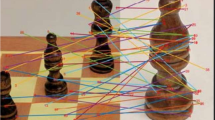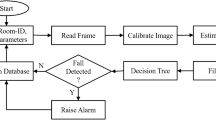Abstract
The medical history explores that Myocardial Infarction has been one of the leading factors of death in human beings since several decades globally. The researchers’ key tasks are to emerge a novel real-time health vision-based monitoring system with added measurement features like high accuracy, robust, reliable, low-cost, low power with high data security. The main purpose of this research is to bestow an advanced non-invasive algorithmic approach for detecting the chest pain posture and fall posture based vital signs of Myocardial Infarction and analyzing the performance of a Faster Region-based Convolution Neural Network algorithm. This object detection computer vision technique is simulated for 3000 three-dimensional real-life indoor environment RGB color images for two datasets Nanyang Technological University Red Blue Green, and Depth dataset and private dataset-RMS trained datasets using TensorFlow object detection Application Programming Interface. The 3D RGB Images of NTU RGB database used for Vital Signs of Myocardial Infarction performance analysis is an improved approach. The simulation results have been compared with the existing works. The demonstrated results of ResNet-101 Faster RCNN showed the evaluated metric values: high mean precision and average recall value is a major contribution in this work.














Similar content being viewed by others
References
Albarracín GR, Chaves MA, Caballero AF (2019) Heart Attack Detection in Colour Images Using Convolutional Neural Networks. Applied Science 9:5065–5074
Amrawy MN (2015) Are currently available wearable devices for activity tracking and heart rate monitoring accurate, precise, and medically beneficial. Health Informatics Research 21(4):315–320
Azimi I, Anzanpour A (2016) Medical warning system based on internet of things using fog computing. International Workshop on Big Data and Information Security
Balla C, Pavasini R, Ferrari R (2018) Treatment of angina: where are we? Cardiology 140:52–67
Bizopoulos P, Koutsouris D (2019) Deep learning in cardiology. IEEE Rev Biomed Eng 12:168–193
Chen Y, He F, Li H (2020) A full migration BBO algorithm with enhanced population quality bounds for multimodal biomedical image registration
Chen T, Jiang Y, Wang J (2020) Maintenance personnel detection and analysis using mask-RCNN optimization on power grid monitoring video. Neural Process Lett 51:1599–1610
David AR, Kershaw A, Heagarty (2010) Atherosclerosis and diet in ancient Egypt. Lancet 375:718–719
Fog Computing in Healthcare (n.d.) A Review and Discussion. IEEE, Vol 5:9206–9222
Girshick R (2015) Fast R-CNN. International Conference on Computer Vision, pp 1–9, arXiv:1504.08083 [cs.CV]
Gorlin R (1996) Pathophysiology of cardiac pain. Circulation 32:138–148
Heberden W (1987) Some account of the disorders of the breast. Clin Cardiol 10(3):211–213
Hildreth CJ, Burke AE, Glass RM (2003) Risk factors for heart disease. The Journal of American Medical Association, 290(7)
Hur T, Bang J, Huynh-The T, Lee J, Kim J-I (2018) A Novel Signal-Encoding Technique for CNN-Based Human Activity Recognition. Sensors 18:3910–3929
Johnson KW, Soto JT, Glicksberg B (2018) Artificial Intelligence in Cardiology. J Am Coll Cardiol 71(23):2668–2679
Lajczyk M, Grochowski (2018) Data augmentation for improving deep learning in image classification problem. International Interdisciplinary PhD Workshop, pp. 117
Lecun Y, Bottou L, Bengio Y (1998) Gradient-based learning applied to document recognition Proc. of the. IEEE 86(11):2278–2324
Lin Z, Doll (2015) Microsoft COCO: common objects in context. Computer Vision, ECCV , pp. 740–755
Lin HY, Hsueh YL, and Lie WN (2016) Abnormal event detection using Microsoft Kinect in a smart home. International Computer Symposium,
Liu J, Shahroudy A, Perez M (2019) NTU RGB+D 120: a large-scale benchmark for 3D human activity understanding. IEEE Trans Pattern Anal Mach Intell, 2019.
Liu L, Ouyang W, Wang X (2020) Deep learning for generic object detection: a survey. Int J Comput Vis 128:261–318
Lu Y (2018) Identification of metastatic lymph nodes in MR imaging with faster region-based convolutional neural networks. American Association for Cancer Research 78(17):5135–5143
Lu K-L, Chu ET-H (2018) An image-based fall detection system for the elderly. Appl Sci 8(10):1995–2026
Malik MA, Khan S, Safdar S (2013) Chest pain as a presenting complaint in patients with acute myocardial infarction. Pakistan Journal of Medical Sciences 29(2):565–568
Moniruzzaman MD, Islam SMS, Lavery P (2020) Faster R-CNN Based Deep Learning for Seagrass Detection from Underwater Digital Images Digital Image Computing: Techniques and Applications (DICTA), IEEE
Mshali H, Lemlouma T, Molone M (2018) A Survey on Health Monitoring Systems for Health Smart Homes International Journal of Industrial Ergonomics 66:26–58
Mshali H, Lemlouma T, Moloney M, Magoni D (2018) A survey on health monitoring systems for health smart homes. International Journal of Industrial Ergonomics 66:26–56
Noury N, Fleury A, Rumeau P, Bourke AK, Laighin O (2007) fall detection – principles and methods pp 1663-1666
Panju AA, Hemmelgarn BR, Guyatt GH (1998) Is this patient having a myocardial infraction. JAMA 280:1256–1263
Patel A (2018) Awareness of Heart Attack Signs and Symptoms and Calling 9–1-1 Among U.S. Adults. Journal of the American college of cardiology, 71(7)
Prati A, Shan C (2019) Sensors, vision and networks: from video surveillance to activity recognition and health monitoring. Journal of Ambient Intelligence and Smart Environments 11:5–22
Profis S (n.d.) Do wristband heart trackers actually work? A checkup. CNET, www.cnet.com/news/how-accurate-are-wristband-heart-rate-monitors.
Rashidi P, Mihalidis A (2013) A survey on ambient-assisted living tools for older adults. IEEE Journal of biomedical and health informatics 17(3):579–590
Ren S, He K, Girshick R (2016) Faster R-CNN: towards real-time object detection with region proposal networks. Computer Vision and Pattern Recognition
Sahoo SP, Ari S (2019) On an algorithm for human action recognition. Expert Syst Appl 115:524–534
Shahroudy A, Liu J, Ng T-T, Wang G (2016) NTU RGB+D: a large scale dataset for 3D human activity analysis. IEEE Conference on Computer Vision and Pattern Recognition, pp:1010–1019. https://doi.org/10.1109/CVPR.2016.115
Shorten C, Khoshgoftaar T (2019) A survey on image data augmentation for deep learning. Journal of big data, 6(60)
Siegersma KR, Leiner C (2019) Artificial intelligence in cardiovascular imaging: state of the art and implications for the imaging cardiologist. Neth Hear J 27:403–413
Smith KL, Cameron P, Meyer A (2002) Knowledge of heart attack symptoms in a community survey of Victoria. Emerg Med 14:255–260
Sokolovaa M, Cuerdab JS, Castillob JC (2013) A fuzzy model for human fall detection in infrared video. Journal of Intelligent & Fuzzy Systems 24:215–228
Stern S, Behar S, Gottlieb S (2003) Circulation, Aging and Diseases of the Heart circulation, 108(14)
Stone E, Skubic M (2015) Fall detection in homes of older adults using the Microsoft Kinect. Journal of Biomedical and Health Informatics, IEEE 19(1):290–301
Sung J, Ponce C, Selman B and Saxena A (2011) Human activity detection from RGBD images. Association for the Advancement of Artificial Intelligence, 47–55
Tang D, Yusuf B, Botzheim J (2015) A novel multimodal communication framework using robot partner for aging population. Expert Syst Appl 42:4540–4555
Theodora P, Hatzis G, Nikolaos P (2017) Socioeconomic status and risk factors for cardiovascular disease: impact of dietary mediators. Hell J Cardiol 58(1):32–42
United Nations, Population Prospects (2019), www.un.org/en/development/desa/population/publications/trends/population projections.asp.
Vaquero LM, Rodero-Merino L (2014) Finding your way in the fog: towards a comprehensive definition of fog computing. ACM SIGCOMM Computer Communication Review, 44(5)
Vijayakumar M (2018) Fog computing-based intelligent healthcare system for the detection and prevention of mosquito-borne diseases computers in human behavior
Vilela PH, Rodrigues J (2020) Looking at Fog Computing for E-Health through the Lens of Deployment Challenges and Applications Sensors, 20
Wang X, Jia K (2020) human fall detection algorithm based on YOLOv3. IEEE 5th international conference on image, Vision and Computing,
World Health Organization, World Health Statistics Overview (2019) www.who.int/gho/publications/ world_ health_statistics/2019/en.
Xu Y, Yu G,Wang Y, Wu X (2017) Car Detection from Low-Altitude UAV Imagery with the Faster R-CNN” Journal of Advanced Transportation, Vol 2017, Article ID 2823617
Yang Q, Xiao D, Lin S (2019) Feeding behavior recognition for group-housed pigs with the faster R-CNN. Comput Electron Agric 155:453–460
Yong J-s, He F, Li H-r (2019) A novel bat algorithm based on cross boundary learning and uniform explosion strategy. Applied Mathematics-A Journal of Chinese Universities 34(4):482–504
Yu G (2017) Ensembles of deep LSTM learners for activity recognition using Wearables proceedings of the ACM on interactive, Mobile, Wearable and Ubiquitous Technologies, 1(11)
Zhang J, He F, Chen Y (2020) A new haze removal approach for sky/river alike scenes based on external and internal clues. Multimed Tools Appl 79(20)
Acknowledgements
The authors would like to express sincere thanks to the organization Digital Shark Technology, Bangalore, for providing hardware resources during the implementation of this work. We thank Dr. Steve Ling, School of Biomedical Engineering, University of Technology, Sydney, Dr. R Srinivasan Ex. Dean R&D, RNSIT, Bangalore and Dr. Rifai Chai, School of Software and Electrical Engineering, Swinburne University of Technology for their encouragement and suggestions during this research work.
Author information
Authors and Affiliations
Corresponding author
Ethics declarations
Declaration of conflict of interest
The authors declare that there is no conflict of interest.
Additional information
Publisher’s note
Springer Nature remains neutral with regard to jurisdictional claims in published maps and institutional affiliations.
Rights and permissions
About this article
Cite this article
Mohan, H.M., Rao, P.V., Kumara, H.C.S. et al. Non-invasive technique for real-time myocardial infarction detection using faster R-CNN. Multimed Tools Appl 80, 26939–26967 (2021). https://doi.org/10.1007/s11042-021-10957-2
Received:
Revised:
Accepted:
Published:
Issue Date:
DOI: https://doi.org/10.1007/s11042-021-10957-2




